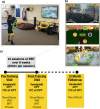Enhancing attention in children using an integrated cognitive-physical videogame: A pilot study
- PMID: 37046040
- PMCID: PMC10097690
- DOI: 10.1038/s41746-023-00812-z
Enhancing attention in children using an integrated cognitive-physical videogame: A pilot study
Erratum in
-
Author Correction: Enhancing attention in children using an integrated cognitive-physical videogame: A pilot study.NPJ Digit Med. 2023 Apr 25;6(1):71. doi: 10.1038/s41746-023-00826-7. NPJ Digit Med. 2023. PMID: 37186002 Free PMC article. No abstract available.
Abstract
Inattention can negatively impact several aspects of a child's life, including at home and school. Cognitive and physical interventions are two promising non-pharmaceutical approaches used to enhance attention abilities, with combined approaches often being marketed to teachers, therapists, and parents typically without research validation. Here, we assessed the feasibility of incorporating an integrated, cognitive-physical, closed-loop video game (body-brain trainer or 'BBT') as an after-school program, and also evaluated if there were attention benefits following its use. Twenty-two children (7-12 years of age) with a range of attention abilities were recruited to participate in this proof of concept, single-arm, longitudinal study (24 sessions over 8 weeks, ~30 min/day). We interrogated attention abilities through a parent survey of their child's behaviors, in addition to objective performance-based and neural measures of attention. Here we observed 95% compliance as well as, significant improvements on the parent-based reports of inattention and on cognitive tests and neural measures of attention that were comparable in scale to previous work. Exploratory measures of other cognitive control abilities and physical fitness also showed similar improvement, with exploratory evaluation of retained benefits on the primary attention-related outcomes being present 1-year later. Lastly, there was no correlation between the baseline parent-rated inattention score and the improvement on the primary task-based measures of attention, suggesting that intervention-based benefits were not solely attained by those who stood the most to gain. These pilot findings warrant future research to replicate and extend these findings.
© 2023. The Author(s).
Conflict of interest statement
A.G. is a co-founder, shareholder, BOD member, and advisor for Akili Interactive Lab, a company that produces therapeutic video games. No other authors report any competing interests.
Figures





References
-
- Coghill, D. R., Banaschewski, T., Soutullo, C., Cottingham, M. G. & Zuddas, A. Systematic review of quality of life and functional outcomes in randomized placebo-controlled studies of medications for attention-deficit/hyperactivity disorder. Eur. Child Adolesc. Psychiatry (2017). 10.1007/s00787-017-0986-y. - PMC - PubMed

